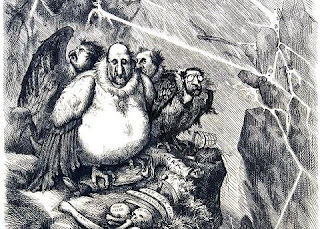The origins of the custom of scalping enemies are unclear-it may
have been introduced by Spanish conquerors in the 1500s, or it may
have begun as an ancient Indian tradition. The practice increased
dramatically among Indians and Europeans in the 1700s, largely as a
result of the Indian scalp bounties set by local authorities as a way to
encourage settlers to help fight hostile Indian tribes. The Indians
retained scalps as war trophies and offerings to spirits, or wore scalp
locks on their belts as warning to their attackers. Shown here are two
Indians from the Southeast displaying their trophies.
 |
In the midst of Pontiac's Rebellion, on December 14, 1763, a mob
from Paxton, Pennsylvania, raided a tribe of peaceful Conestoga
Indians, setting fire to their village and killing six. The mob's purpose
was to seek revenge against all Indians, whether or not they were
allied with Pontiac. Fourteen survivors fled to Lancaster, where they
were placed in protective custody. On December 27, the Paxton Mob
stormed the jail and massacred the rest. Benjamin Franklin
condemned the act an, fearing genocide, brought several hundred
Moravian Indians to safety in Philadelphia. The Paxton Mob
descended on the city, only to be turned back by thousands of
Philadelphians who were waiting for them at the courthouse (shown
here). The mob returned to Paxton; in spite of the outrage they
caused, charges were never brought against them.
Pontiac was born around 1720 in what is now northern Ohio. At the
|
age of thirty-five, he became chief of the Ottawas, and an influential
Indian leader in the Woodlands region. Under Pontiac's leadership,
the Algonquian-speaking tribes of the Northwest-the Ottawa,
Chippewa, Potawatomi, and Miami-formed a league similar to the
Iroquois Confederacy. He is shown addressing the council in this
nineteenth-century painting. Pontiac had been friendly with the
French, but allowed British troops to enter his territory after their
victory in the French and Indian War. Conflicts flared up with British
settlers, however, and Pontiac organized the series of attacks known
as Pontiac's Rebellion or Pontiac's Conspiracy. He made peace with
the British in1766. Three years later he died, probably murdered by
an Indian in the pay of the British.

The French and Indian War of 1754-63 was the culmination of
French efforts to drive British fur traders out of the Ohio Valley. In
1755, Major General Edward Braddock, the British commander-in-
chief in North America, planned to seize Fort Duquesne in
Pennsylvania from the French. His party was ambushed by French,
Canadian, and Indian forces. Braddock, accustomed only to the
European style of fighting and ill-equipped to do battle in the
wilderness, could not effectively command his troops. He was killed
in the struggle. By the war's end, however, the British emerged
victorious and gained control of all territories previously owned by
the French outside Louisiana.
Joseph Brant, born in 1742, was a Mohawk chief who helped gain
Indian support for the British in the French and Indian War between
1754 and 1763. From 1763 to 1776, Brant and his tribe assisted the
British in the American Revolution by attacking the American
settlers. After the Revolution, unable to negotiate a land settlement
with the American government, Brant obtained a land grant in
Canada and he and his followers settled in the area now known as
Brantford, Ontario, which was named after him. The last years of his
life were spent seeing to the welfare of his people and translating the
Bible into the Mohawk language. He died in 1807.
Near the end of the French and Indian War, Chief Pontiac led attacks
on the weakly defended forts located in the eastern portion of the
colonies. Fort Pitt, however, held strong under the leadership of
Colonel Henry Bouquet. Bouquet had ensured that his troops were
ready for wilderness warfare, thereby avoiding the disastrous
mistake made in 1755 by Edward Braddock. On August 5, 1763,
Bouquet turned back the Shawnee and Delaware Indians and the
next day concluded victory at the famous battle of Bushy Run. The
following year, Bouquet succeeded in obtaining the return of
hostages taken by the Ohio Indians, and is shown above negotiating
the terms of their release.

During the Revolutionary War (1775-1783), the Iroquois League,
along with some other Indian groups, sided with the British against
the Americans. In the summer of 1777, British General John
Burgoyne marched south down the Hudson from Canada to Albany.
Along the way, some Indian warriors who had joined the marched
began killing American settlers indiscriminately. One of the victims
was Jane McCrea, whose murder is shown here in this Currier and
Ives print, dated 1846. News of this attack traveled swiftly among
the colonists, inciting many young men to enlist with American
forces in the Continental Army to fight against Burgoyne.

The Cherokees generally sided with the British in the French and
Indian War. In 1760, however, a dispute erupted between some
Virginia frontiersmen and a Cherokee tribe over a group of wild
horses. The Englishmen killed twelve Cherokees and collected
bounties on their scalps. News of the incident incited Cherokee chief
Oconostota to make raids on British settlements. The British
retaliated with a "scorched earth" policy, decimating villages and
crops in the Carolina Territory until the Cherokees surrendered
in1761. The Cherokees found British rule authoritarian and
financially stringent, and to alleviate tensions, Kinf George III invited
a delegation of chiefs to come to London in 1762. There, they were
showered with gifts and ornaments, such as the silver gorgets (neck
pieces) engraved with the king's imprint, shown in this group
portrait.
Image and text source link
here.















